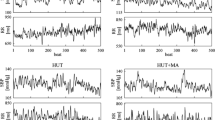Abstract
A method is described which allows the determination of the causal relationship existing between two biological signals (heart rate and arterial blood pressure variability signals) which carry information about the role of control elicited by the autonomic nervous system. This method assumes an autoregressive (AR) model for the two signals to check the cross-correlation of the two residuals after AR identification. This information, together with the classical parameters of the spectral analysis (mean, variance, frequency and power in two typical bands, gain, phase and coherence) may provide a more precise evaluation of the complex mechanisms involved in the control of heart rate and blood pressure in numerous physiopathological situations.
Similar content being viewed by others
References
Ahmed, A.J., Harness, J.B., Mason, J. andMearns, A.J. (1981) Cross correlation between blood pressure and intracranial pressure.Clin. Phys. Physiol. Meas.,2, 157–162.
Akselrod, S., Gordon, D., Ubel, F.A., Shannon, D.C., Barger, A.C. andCohen, R.J. (1981) Power spectrum analysis of heart rate fluctuations: a quantitative probe of beat-to-beat cardiovascular control.Science,213, 220–222.
Akselrod, S., Gordon, D., Madwed, J.B., Snidman, N.C., Shannon, D.C. andCohen, R.J. (1985) Hemodynamic regulation: investigation by spectral analysis.Am. J. Physiol.,249, M867-M875.
Baselli, G., Cerutti, S., Civardi, S., Liberati, D., Lombardi, F., Malliani, A. andPagani, M. (1986a) Spectral and cross-spectral analysis of heart rate and arterial blood pressure variability signals.Comput. & Biomed. Res.,19, 520–534.
Baselli, G., Cerutti, S., Civardi, S. andRizzo, G. (1986b) Toward a modelisation of heart rate and blood pressure interaction through parametric bivariate analysis. Computers in Cardiology, IEEE, Boston, USA.
Baselli, G., Cerutti, S., Civardi, S., Malliani, A., Orsi, G., Pagani, M. andRizzo, G. (1988) Parameter extraction from heart rate and arterial blood pressure variability signals in dogs for the validation of a physiological model.Comput. in Biol. & Med.,18, (1), 1–16.
Caines, P.E. andChan, C.W. (1975) Estimation, identification and feedback. Research Report 7510, Department of Electrical Engineering, University of Toronto, Toronto, Canada.
de Boer, R.W., Karemaker, J.M. andStrackee, J. (1985) Relationships between short-term blood-pressure fluctuations and heart-rate variability in resting subjects I: a spectral analysis approach.Med. & Biol. Eng. & Comput.,23, 352–358.
de Boer, R.W., Karemaker, J.M. andStrackee, J. (1987) Haemodynamic fluctuations and baroreflex sensitivity in humans: a beat to beat model.Am. J. Physiol.,243, 680–689.
de Trafford, J.C., Lafferty, K., Kitney, R.I., Cotton, L.T. andRoberts, V.C. (1982) Modelling of the human vasomotor control system and its application to the investigation of arterial disease.IEE Proc.,129A, 646–650.
Geweke, J. (1982) Measurement of linear dependence and feedback between multiple time series.J. Am. Statistical Assoc.,77, 304–313.
Granger, C.W.J. (1963) Economic processes involving feedback. InInformation and control, vol. 6.Granger, C.W.J. andHatanaka, M.N.J. (Eds.), Princeton Press.
Granger, C.W.J. (1969) Investigating causal relations by econometric models and cross-spectral methods.Econometrica,37, 424–438.
Granger, C.W.J. (1980) Testing for causality: a personal viewpoint.J. Economics, Dynamics & Control,2, 329–352.
Haugh, L.D. (1972) The indentification of time series interrelationships with special reference to dynamic regression. Ph.D. dissertation, Department of Statistics, University of Wisconsin, Madison, Wisconsin, USA.
Haugh, L.D. (1976) Checking the independence of two covariance-stationary time series: a univariate residual cross-correlation approach.J. Am. Statistical Assoc.,71, 378–385.
Hyndman, B.W., Kitney, R.I. andSayers, B. McA. (1971) Spontaneous rhythms in physiological control system.Nature,233, 339–341.
Kitney, R.I. andRompelman, O. (Eds.) (1980)The study of heart rate variability. Oxford University Press.
Kitney, R.I. andRompelman, O. (Eds.) (1987)The beat-by-beat investigation of cardiovascular function. Clarendon Press.
Orlebeke, J.F., Mulder, G. andvan Doomen, L.J.P. (Eds.) (1985)Psychophysiology of cardiovascular control: models, methods and data. Plenum Press.
Pagani, M., Pizzinelli, P., Bergamaschi, M. andMalliani, A. (1982) A positive feedback sympathetic pressor reflex during stretch of the thoracic aorta in conscious dogs.Circ. Res.,50, 125–132.
Pagani, M., Furlan, R., Dell'Orto, S., Pizzinelli, P., Baselli, G., Cerutti, S., Lombardi, F. andMalliani, A. (1985) Simultaneous analysis of beat-to-beat systemic arterial pressure and heart rate variability signals in ambulatory patients.J. Hypertension,3, Suppl. 3, S83-S85.
Pagani, M., Lombardi, F., Guzzetti, S., Furlan, R., Pizzinelli, P., Rimoldi, S., Sandrone, G., Malfatto, G., Dall'Orto, S., Piccaluga, E., Turiel, M., Baselli, G., Cerutti, S. andMalliani, A. (1986) Power spectral analysis of beat-to-beat heart and blood pressure variability signals as a possible marker of sympatho-vagal interaction in man and conscious dog.Circ. Res.,59, 178–193.
Pierce, D.A. (1975) Forecasting in dynamic models with stochastic regression.J. Econometrics,3, 349–374.
Pierce, D.A. andHaugh, L.D. (1977) Causality in temporal systems: characterizations and a survey.Ibid., J. Econometrics,3, 265–293.
Pierce, D.A. andHaugh, L.D. (1979) Comment on price.Ibid., J. Econometrics,10, 257–260.
Price, J.M. (1979) A characterization of instantaneous causality: a correction.Ibid., J. Econometrics,10, 253–256.
Sayers, B. McA. (1973) Analysis of heart rate variability.Ergonomics,16, 17–32.
Veldman, J.B.P., Mulder, L.J.M., Mulder, G. andvan der Heide, D. (1985) Short-term coherence between blood pressure and heart rate during mental loading: an exploration in the time and in the frequency domain. InPsychophysiology of cardiovascular control: models, methods and data.Orlebeke, J.F., Mulder, G. andvan Doomen, L.J.P. (Eds.), Plenum Press, New York.
Author information
Authors and Affiliations
Rights and permissions
About this article
Cite this article
Baselli, G., Cerutti, S., Livraghi, M. et al. Causal relationship between heart rate and arterial blood pressure variability signals. Med. Biol. Eng. Comput. 26, 374–378 (1988). https://doi.org/10.1007/BF02442294
Received:
Accepted:
Issue Date:
DOI: https://doi.org/10.1007/BF02442294




